您好,登錄后才能下訂單哦!
您好,登錄后才能下訂單哦!
這篇文章主要介紹Python3.5字符串常用操作的示例分析,文中介紹的非常詳細,具有一定的參考價值,感興趣的小伙伴們一定要看完!
具體如下:
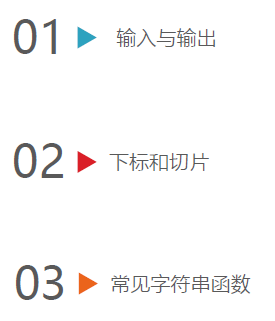
一、輸入與輸出
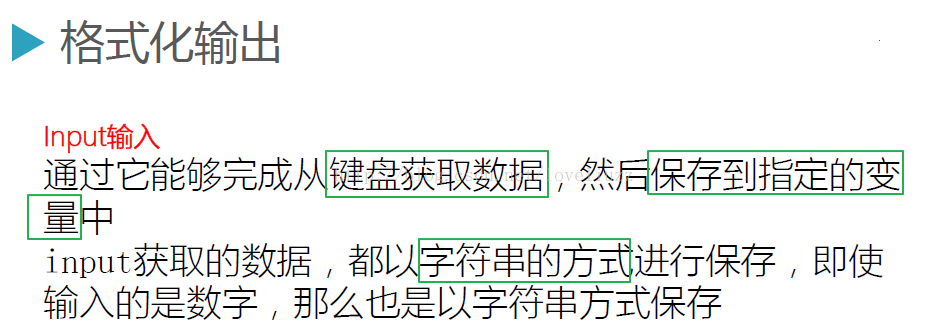
#輸入與輸出
str = input("請輸入任意字符:")
print(type(str)) #input獲取的數據類型皆為字符串
print(str)運行結果:
請輸入任意字符:abc
<class 'str'>
abc
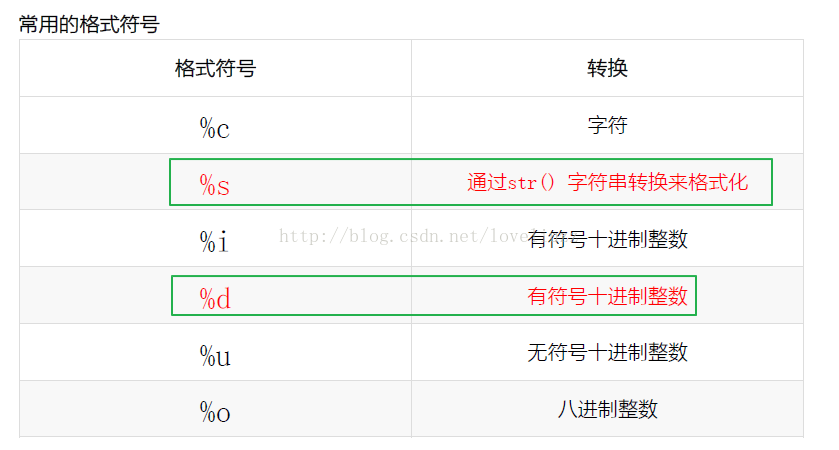
#格式化輸出
name = "liu"
age = 18
print("My name is %s, and I'm %d years old" %(name,age))運行結果:
My name is liu, and I'm 18 years old
二、字符串下標與切片
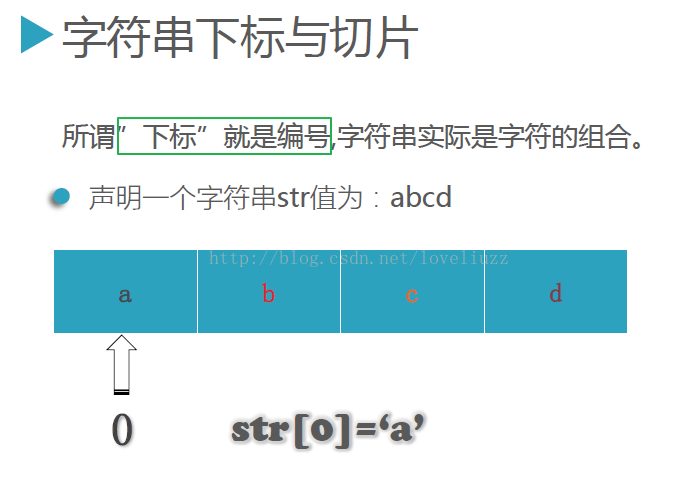
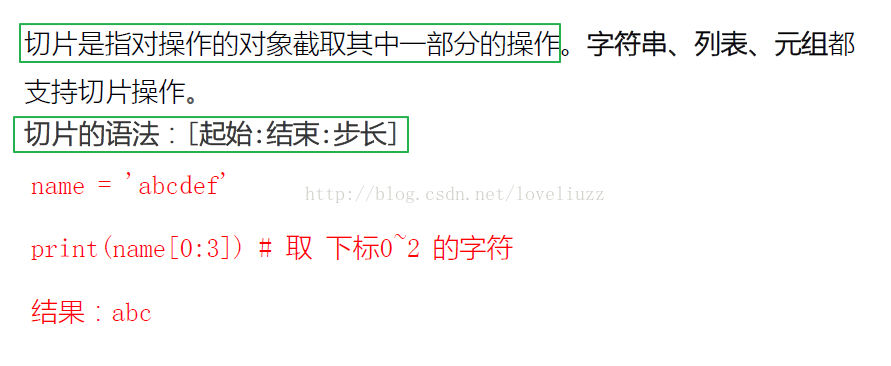
三、字符串常用操作
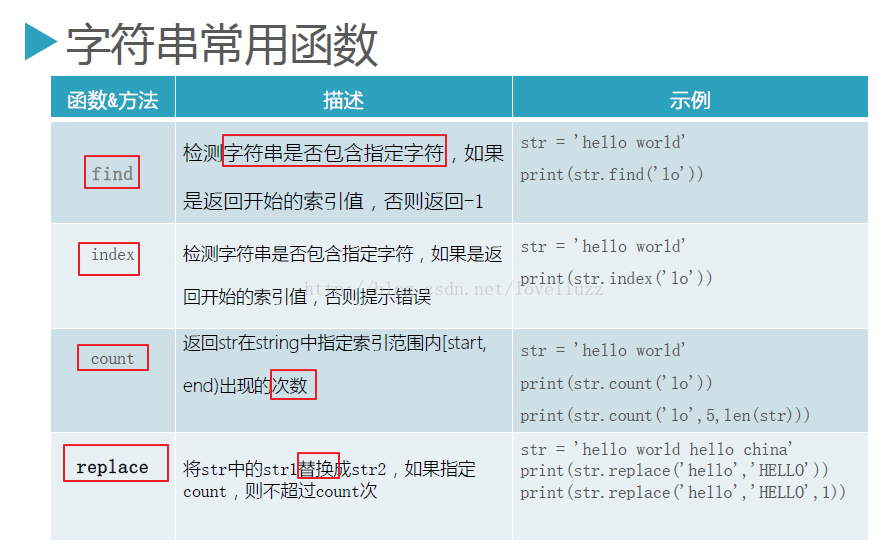
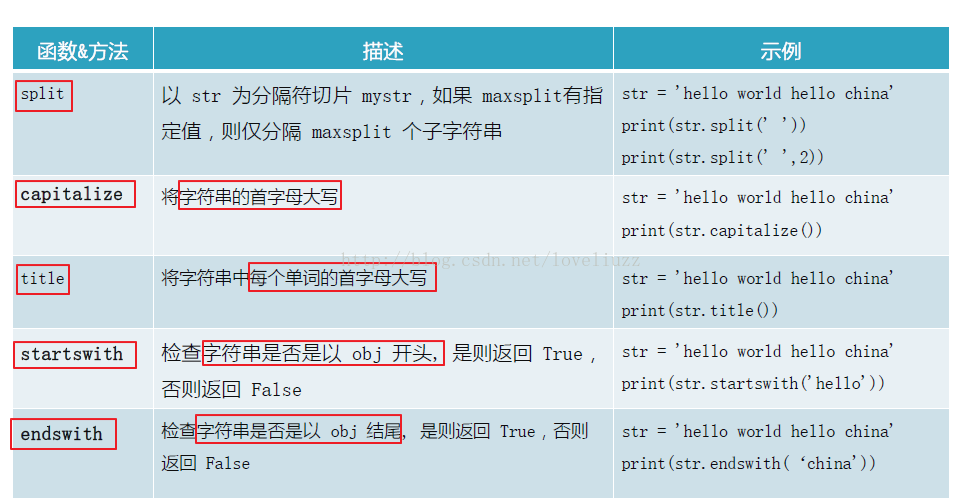
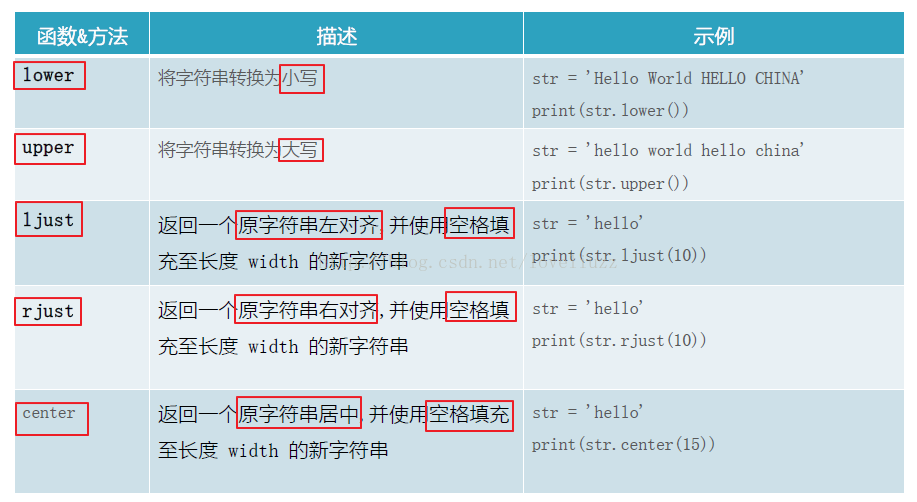
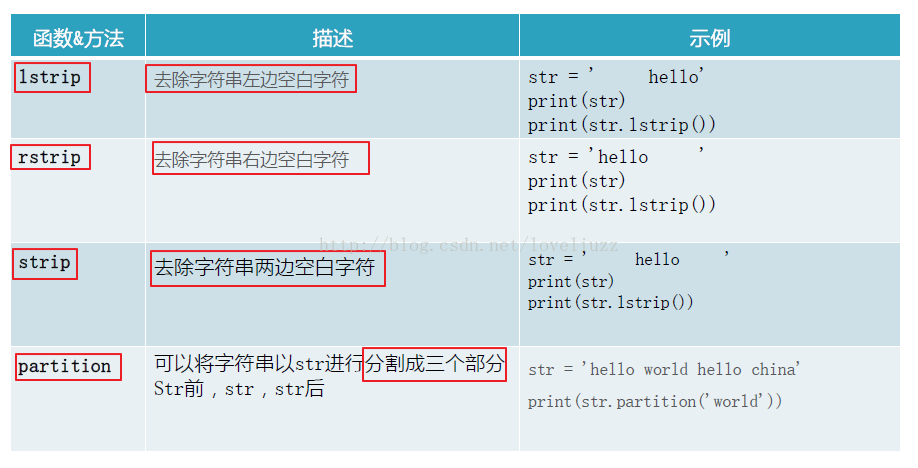
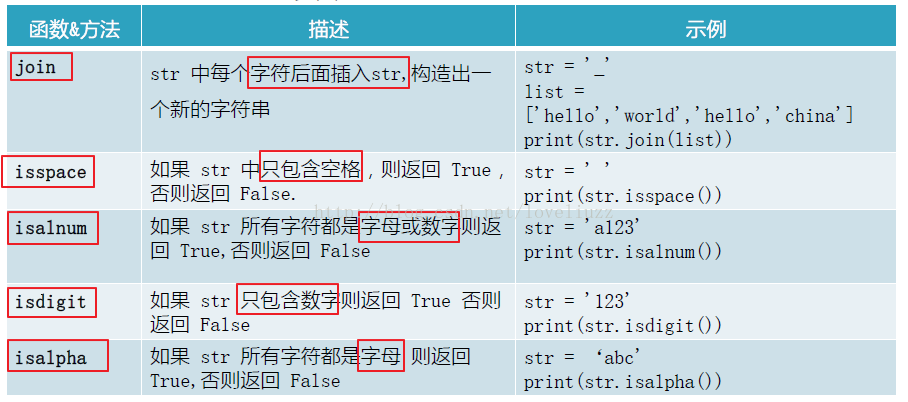
1、字符串常用操作——首字母大寫:調用.capitalize()方法
#!/usr/bin/env python # -*- coding:utf-8 -*- # Author:ZhengzhengLiu name = "liu" print(name.capitalize())
運行結果:
Liu
2、字符串常用操作——統計字符出現的個數:調用.count()方法
name = "my name is liu"
print(name.count("m")) #獲取字符串中m的個數
print(name.count("na",3,len(name))) #len獲取字符串的長度運行結果:
2
1
3、字符串常用操作——美觀打印,將字符串放到中間,其余用定義的線型填充:調用.center()方法
name = "my name is liu" print(name.center(50,'-'))
運行結果:
------------------my name is liu------------------
4、字符串常用操作——判斷一串字符串是否以某些字符結尾:調用.endswith()方法
name = "my name is liu"
print(name.endswith('iu'))運行結果:
True
5、字符串常用操作——將\t轉換成定義長度的空格:調用.expandtabs()方法
name = "my \tname is liu" print(name.expandtabs(tabsize=30))
運行結果:
my name is liu
6、字符串常用操作——查找字符的索引:調用.find()方法(找不到返回-1)
name = "my name is liu"
print(name.find("name"))
#利用字符串也可以進行切片
print(name[name.find("name"):7])運行結果:
3
name
7、字符串常用操作——格式化:調用.format()或.format_map(字典)方法
name = "my name is {name} and i am {years} old"
print(name.format(name = 'Liu',years = 18))
print(name.format_map({'name':'Wang','years':26}))運行結果:
my name is Liu and i am 18 old
my name is Wang and i am 26 old
8、字符串常用操作——判斷字符串是否都為阿拉伯數字或字符:調用.isalnum()方法
print('abe146'.isalnum())運行結果:
True
9、字符串常用操作——判斷字符串是否都為英文字符:調用.isalpha()方法
print('abe146'.isalpha())運行結果:
False
10、字符串常用操作——判斷字符串是否為十進制:調用.isdecimal()方法
print('1A'.isdecimal())運行結果:
False
11、字符串常用操作——判斷字符串是否為整數:調用.isdigit()方法
print('35'.isdigit())運行結果:
True
12、字符串常用操作——判斷是否為合法的標識符(是否為合法的變量名):調用.isidentifier()方法
print('-water'.isidentifier())運行結果:
False
13、字符串常用操作——判斷是否為小寫:調用.islower()方法
print('you'.islower())運行結果:
True
14、字符串常用操作——判斷字符串是否為只有數字:調用.isnumeric()方法
print('33.4'.isnumeric())運行結果:
False
15、字符串常用操作——判斷是否為空格:調用.isspace()方法
print(' '.isspace())運行結果:
True
16、字符串常用操作——判斷是否為標題(每個單詞首字母大寫):調用.istitle()方法
name1 = "My Name Is Liu" print(name1.istitle())
運行結果:
True
17、字符串常用操作——判斷是否能夠打印(字符都能夠打印,對于tty文件或driver驅動程序不能打印):調用.isprintable()方法
name1 = "My Name Is Liu" print(name1.isprintable())
運行結果:
True
18、字符串常用操作——判斷是否為大寫:調用.isupper()方法
print('NAME'.isupper())運行結果:
True
19、字符串常用操作——用指定的符號連接列表里面的每個元素:調用.join()方法
print('|'.join(['Wang','Sun','Liu']))
print('+'.join(['1','2','3']))運行結果:
Wang|Sun|Liu
1+2+3
20、字符串常用操作——打印形式,將字符串放到前面,剩余部分用定義的線型在最后填充:調用.ljust()方法
name1 = "My Name Is Liu" print(name1.ljust(50,'*'))
運行結果:
My Name Is Liu************************************
21、字符串常用操作——打印形式,將字符串放到后面,剩余部分用定義的線型在前面填充:調用.rjust()方法
name1 = "My Name Is Liu" print(name1.rjust(50,'-'))
運行結果:
------------------------------------My Name Is Liu
22、字符串常用操作——將大寫的字符串轉變成小寫:調用.lower()方法
print('NAME'.lower())運行結果:
name
23、字符串常用操作——將小寫的字符串轉變成大寫:調用.upper()方法
print('name'.upper())運行結果:
NAME
24、字符串常用操作——去掉左邊的空格和回車:調用.lstrip()方法
去掉右邊的空格和回車:調用.rstrip()方法、
去掉兩邊的空格和回車:調用.strip()方法
print('name'.upper())
print('\nLiu'.lstrip() )
print('Liu\n'.rstrip() )
print(' \nLiu\n'.strip() )
print('-----')運行結果:
NAME
Liu
Liu
Liu
-----
25、字符串常用操作——隨機密碼編寫,將前后相等數量的字符串一一對應:調用.maketrans()方法
p = str.maketrans('abcdefli','123&*456')
print("lifedc".translate(p))運行結果:
564*&3
26、字符串常用操作——替換字符,調用:.replace()方法
str = "hello world hello china"
print(str.replace("hello","HELLO"))
print(str.replace("hello","HELLO",1)) # 1 指定替換次數運行結果:
HELLO world HELLO china
HELLO world hello china
27、字符串常用操作——找到字符串中某個字符所在的最后的位置,調用.rfind()方法
print('Liu Sanabga'.rfind('a'))運行結果:
10
28、字符串常用操作——將字符串按照指定的符號分割成一個列表(默認按照空格分),調用.split()方法
print('Liu Sanabga'.split())
print('1+2+3+4'.split('+'))運行結果:
['Liu', 'Sanabga']
['1', '2', '3', '4']
29、字符串常用操作——將字符串按照換行符分割成一個列表,調用.splitlines()方法
print('1+2\n3+4'.splitlines())運行結果:
['1+2', '3+4']
30、字符串常用操作——將字符串的大小寫字符互換,調用.swapcase()方法
print('CHUN tian'.swapcase())運行結果:
chun TIAN
31、字符串常用操作——將字符串的元素變成標題形式(單詞首字母大寫),調用.title()方法
print('chun tian'.title())運行結果:
Chun Tian
32、字符串常用操作——在字符串前面自動用0補位,調用.zfill()方法
print('chun tian'.zfill(20))運行結果:
00000000000chun tian
以上是“Python3.5字符串常用操作的示例分析”這篇文章的所有內容,感謝各位的閱讀!希望分享的內容對大家有幫助,更多相關知識,歡迎關注億速云行業資訊頻道!
免責聲明:本站發布的內容(圖片、視頻和文字)以原創、轉載和分享為主,文章觀點不代表本網站立場,如果涉及侵權請聯系站長郵箱:is@yisu.com進行舉報,并提供相關證據,一經查實,將立刻刪除涉嫌侵權內容。